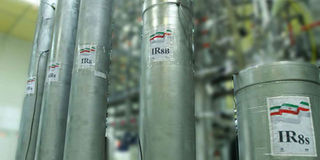The hard-won 2015 Iran nuclear deal

This picture provided on November 4, 2019 shows IR-8 centrifuges at Natanz nuclear power plant, some 300 kilometres south of capital Tehran. PHOTO | HO | ATOMIC ENERGY ORGANIZATION OF IRAN | AFP
What you need to know:
- The final deal is reached in July 2015, bringing an end to a 12-year row over the Iran nuclear issue.
The goal of the deal is to render it practically impossible for Iran to build an atomic bomb while pursuing a civil nuclear programme.
- On January 5, Iran announces its fifth reduction in its nuclear commitments, saying it will forgo the limit on the number of centrifuges.
- It comes amid Iranian fury after a US drone strike kills a top Iranian military commander in Iraq.
Tehran,
Iran agreed with major world powers in 2015 to freeze its nuclear programme in return for the lifting of punishing international sanctions.
But in 2018, President Donald Trump pulled the United States out of the agreement and reimposed sanctions, prompting Iran to roll back its own commitments.
Despite consistent denials from Tehran, the US and Israel continue to accuse Iran of seeking a nuclear weapon.
Here is a look back at the deal.
Negotiations start in June 2013 between Iran and the five permanent members of the UN Security Council -- Britain, China, France, Russia and the United States -- plus Germany.
The final deal is reached in July 2015, bringing an end to a 12-year row over the Iran nuclear issue.
The goal of the deal is to render it practically impossible for Iran to build an atomic bomb while pursuing a civil nuclear programme.
Tehran pledges to reduce its nuclear capacities for several years, including by capping its enrichment of uranium at 3.67 per cent, sufficient for power generation but far below the more than 90 per cent required for a nuclear weapon.
Iran agrees to slash the number of its enrichment centrifuges from more than 19,000 to 5,060, and to maintain that level for a decade.
It also agrees to modify its heavy water reactor in Arak to make it impossible to produce plutonium for military use.
The deal comes into effect in January 2016.
The International Atomic Energy Agency is charged with inspections to ensure Iran is keeping its side of the bargain.
The accord paves the way for a partial lifting of international sanctions on Iran, opening the door to foreign investors.
UN embargoes on the sale of conventional arms and on ballistic missiles to Iran are however maintained up to 2020 and 2023 respectively.
But in May 2018, Trump pulls out of the agreement, calling it "rotten".
In August and November, Washington reimposes sanctions, particularly targeting Iran's oil and finance sectors.
From May 2019, Washington ends temporary sanctions waivers it had granted to the eight main purchasers of Iranian oil.
Iran announces in May 2019 that it will stop observing restrictions on its stocks of enriched uranium and heavy water.
It says the European Union, China and Russia must find ways to help it circumvent US sanctions and sell oil, otherwise it would abandon more of the terms of the deal.
In turn Trump announces new measures on iron, steel, aluminium and copper.
In July, Iran says it has exceeded the uranium enrichment cap of 3.67 per cent.
In September, it lifts all restrictions on nuclear research and development. By November, enrichment reaches 4.5 per cent.
On January 5, Iran announces its fifth reduction in its nuclear commitments, saying it will forgo the limit on the number of centrifuges.
It comes amid Iranian fury after a US drone strike kills a top Iranian military commander in Iraq.





